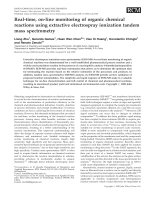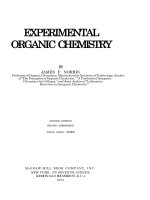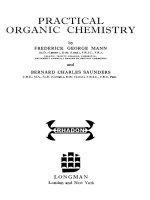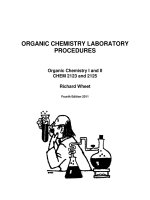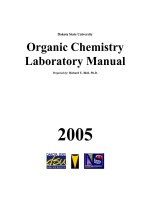QuickStudy organic chemistry reactions
Bạn đang xem bản rút gọn của tài liệu. Xem và tải ngay bản đầy đủ của tài liệu tại đây (1.26 MB, 4 trang )
BarCharts,Inc.®
WORLD’S #1 ACADEMIC OUTLINE
FEATURES OF AN
ORGANIC REACTION
Mechanism: Describes the overall reaction using a
series of simple steps.
Stoichiometry: Calculate reactant and product
masses using the balanced equation and molar
masses.
Kinetics: The study of the reaction rate and mechanism.
Theoretical yield: Mass of product given by a
complete reaction;
%yield=100%x(product mass)÷(theoretical yield).
Equilibrium: Reaction does not proceed to
completion, instead, it reaches a balanced state of
forward and reverse reactions.
Major reaction types:
• Acid
• Base
• Oxidation Reduction
• Condensation
• Substitution (SN1, SN2)
• Ionic Reaction
•
•
•
•
•
Elimination (E1, E2)
Cyclization
Hydrolysis
Addition
Radical reaction
ORGANIC ACID AND BASE
ALKENE
Acid:
Properties: Similar to alkane; non-polar, flammable
• Electron-pair acceptor (Lewis acid)
• Proton donor (Bronsted-Lowry acid);
example: carboxylic acid
• Electron-pair donor (Lewis base)
• Proton acceptor (Bronsted-Lowry base);
example: amine
Factors enhancing acid strength (HA):
• Weaker H-A bond
• Greater electronegativity of “A”
• Inductive effect of substituent on “A”
(electron withdrawal enhances transfer).
• More “s” character in hybrid orbital
(s-orbital is lower in energy than p-orbital)
• Resonance stabilized conjugate base (A-)
Factors enhancing base strength:
• Reverse of acid-strength guidelines
A base is a nucleophile; Electronic effects which shift
electron density to the atom with the lone-pair
increases base-strength.
• Diels Alder: form cyclic alkene
• Friedel-Crafts: add acyl or akyl group
• Grignard: add alkyl or aryl group
• Wolf-Kirschner, Clemmenson: reduce ketone to
alkane
• Wittig: convert aldehyde/ketone to alkene
KINETICS AND
REACTION MECHANISM
Energy
TS
Ea
P
R
Reactant
Reaction Coord
ALKANE
C
C
R
Product
P
Transition state (TS): Maximum on the reactioncoordinate curve: the least stable intermediate.
Activation Energy (Ea): Energy of the TS relative to
the reactant. The change in enthalpy (∆H) is < 0 for
exothermic; > 0 for endothermic.
Hammond-Leffler postulate: The TS is more like
the reactant or product that is closer in energy;
endothermic TS is like the product, exothermic TS is
like the reactant.
Kinetic vs. thermodynamic control: ∆G and ∆H
describe Thermodynamic Stability.
• If ∆G is large and negative (exergonic), the product
formation is likely controlled by “thermodynamics.”
Large Keq corresponds to a large amount of product,
relative to reactant.
• A large Ea may give rise to “kinetic” control; the
energy of the TS controls the reaction, instead of
the product-reactant thermodynamics.
Solvent effects: A solvent may stabilize an
intermediate, decreasing Ea and increasing the rate of
the reaction. Charged-complexes are stabilized by
polar solvents.
CH3
• Hydrocarbon
• Weak intermolecular forces
• Non-cyclic: general formula CnH2n+2
• Tetrahedral C-C-C (109˚)
Ha
Ha
H
He
He
Ha
H
H
H
Ha
Chair
H
H
Ha
H
H
H
He
He
H
H
Ha
He
H
Boat
Synthesis:
• Hydrogenate alkene or alkyne (H2, Pt catalyst)
• Free-radical reaction of alkene
• Reduce haloalkane (Zn, H+)
• Friedel-Crafts alkylation
Reaction:
• Combustion: alkane + O2 => CO2 + H2O
• Halogenation to haloalkane (Cl2/Br2, light or heat)
1
H
C
C
H
CH3
(E)-2-Butene
trans-2-butene
• E/Z; prioritize groups by atomic weight (Z - higher
priority groups on the same side)
• For noncyclic: cis is less stable (steric hindrance).
For cyclic, cis more stable.
• Hofmann Rule: Form the least-substituted alkene
• Markovnikof Addition: H adds to C with most -H’s
• Zaitsev Elimination: Form alkene with more
substitution
• Bicyclic - two fused or bridged rings
• n = 3: cyclopropane: (highly strained)
• n = 4: cyclobutane: (some flexiblity)
• n = 5: cyclopentane: (slight puckering)
• n = 6: cyclohexane: chair - stable conformer;
boat - less stable; Axial position: “perpendicular” to
ring; Equatorial position: in ring “plane”
(see Ha and He in chair diagram below)
• Cis - two substituents in up position
• Trans - one up and one down
He
H3C
C
H
H
(Z)-2-Butene
cis-2-butene
Properties:
Cycloalkane: (CnH2n)
∆H
∆H
Isomers: no free rotation of C=C
C
• Add “-ane” to prefix
• Locate substituent by position #
• Haloalkane: substitute halide for -H
P
Ea
• Add -ene to prefix; Use # to denote C=C position
• Isolated C-C=C-C-C=C; cumulative -C=C=C• Polyunsaturated fatty acid: 2 or more C=C
• Allene: adjacent C=C=C
• Vinyl group: H2C=CH• Methylene group: H2C=
• Allyl group: H2C=CH-CH2• Vinyl halide: halide replaces -H on >C=C<
• Conjugated: alternate C-C and C=C (resonance)
• Alkadiene, 2 conjugated C=C; example: butadiene;
s-cis and s-trans (rotate about C-C bond)
• Alkatriene, 3 conjugated C=C
• Annulene: conjugated monocyclic compound;
example: [6] annulene = benzene
• Aromatic cyclic ions: cyclopentadiene anion,
cycloheptatriene cation (6 electrons)
H3C
Nomenclature:
TS
R
Nomenclature:
Base:
Important named reactions:
>C=C<
Synthesis:
• Dehydrate alcohol (H+, heat) (elimination)
• Dehydrohalogenate haloalkane (base, heat)
• Dehalogenate vic dihalide (Zn, acetic acid)
• Hydrogenate alkyne:
• syn, Z/cis-isomer (H2,P-2 catalyst)
• anti, E/trans-isomer (Li, NH3, -78˚C)
• Wittig, aldehyde/ketone + phosphorous ylide
Reaction:
• Combustion (O2)
• Hydrate to 2˚/3˚ alcohol (H+, H2O); 1˚ from ethene;
can rearrange (Markovnikov)
• Hydrate to alcohol; hydroborate/oxidize
(THF/B2H6,H2O2/OH-) (syn, anti-Markovnikov)
• Oxymercurate-demercurate to alcohol
• Hydrohalogenate (HX) (Markovnikov)
• Halogenate (Br2/Cl2), vic dihaloalkane (X2,CCl4; anti)
• Halohydrin (X2, H2O; anti-addition)
• Hydroxylate to form a 1,2-diol (KMnO4, cold OH-;
syn addition)
• Oxidize to carboxylic acid (KMnO4, hot OH-)
• Ozonolyze to ketone (O3; Zn, H2O)
• Hydrogenate to alkane (Pt, H2; syn-addition)
• Free radical polymerization
• Alkadiene Reaction
• allylic halogenation (Cl2, heat)
• Diels-Alder: cycloalkene from diene + alkene/alkyne
BENZENE/ARENE
ALKYNE
Properties: insoluble in water, miscible with nonpolar organic solvents.
Properties:
ortho
meta
Nomenclature:
C
C
• Aromatic (or arene):
3 2
Denote substituent using para C 4
1C R
3 2
group name and ring
C
C
position; ortho (1,2),
ortho
meta
meta (1,3), para (1,4);
• examples: benzene C6H6;
phenol, Ar-OH (carbolic acid, hydroxybenzene,
benzenol); aniline Ar-NH2; toluene, Ar-Me (methyl
benzene); xylene, dimethyl benzene
• Fused rings: naphthalene, C10H8 (2 edge-sharing rings)
• Aryl or Phenyl group: Ar- (remove H from
benzene)
• Aryl halide: halogen replaces an H atom; Ar-X
• Alkenyl benzene: Ar-C=C<
• Benzyl: Ar-CH2-
Synthesis: Dehydrogenate cyclohexane (sulfur+ heat)
General Reaction:
• Combustion (similar to alkane)
• Birch reduction => 1,4 cyclohexadiene (Na, NH3, EtOH)
• Hydrogenate to cyclohexane (H2, Pt)
Electrophilic substitution:
• Ar-Cl (Cl2, FeCl3)
Properties:
• Hydrocarbon, at least 1 C ≡ C triple bond
• Properties similar to alkane or alkene
• Linear R”-C≡C-R’
• The most common is Phenol, Ar-OH
• Acidic hydrogen, ArO-H; pKa=9.9
• Ring substituent alters acidity
• Benzendiol, HO-Ar-OH; para, hydroquinone; ortho,
catechol; meta, resorcinol
Nomenclature:
• Add -yne to prefix
• Number denotes position of triple bond;
example: ethyne (acetylene) C2H2
Reaction of Phenol:
• Electrophilic substitution: o-p director
• Hydrogenate to cyclohexane (H2, catalyst)
• Form ester (acid anhydride or acid chloride)
Synthesis:
• CaC2 + H2O => Ca(OH)2 + C2H2
• Dehydrohalogenate vic-haloalkene (NaNH2, liq NH3)
• Alkylate terminal alkyne (NaNH2, liq NH3; R-X)
Reaction:
oxidation/acid => phenol + acetone
• Aryl halide (Ar-X) + NaOH, heat and acid
• Ar-OR + HI/HBr, heat
• Ozonolyze to carboxylic acid (O3, H2O)
• Oxidize to carboxylic acid (KMnO4, OH-; H+)
HALOALKANE/
ALKENE/ARENE
R-OH
• Halogen (X = fluorine, chlorine, bromine or iodine)
replaces -H on hydrocarbon group
• Denote halogen in the name;
example: Chloromethane: Cl-Me; chlorobenzene Ar-Cl
Synthesis: alcohol (ROH) + HX
Reaction:
Reactivity of substituted benzene:
• A substituent alters the ring electronic structure.
• Activating group: More reactive than benzene; add
electrons to the ring,
H
H
stabilize the arenium cation
C C
• Deactivating group: Less
reactive; pull electrons
from the ring, destabilize
the arenium cation
• Ortho/para-director:
• substituent tends to activate
the ring (except for -X);
electron density donated to
ring creates “-” center on o/p
sites, o/p isomers are preferred
• examples: -NR2, -OH, -R,
-OR, -X (halogen)
• Meta-director:
• substituent tends to deactivate
the ring; electron density
withdrawn from the ring
creating “+” center on o/p site,
m- preferred reaction site.
• examples: -NO2, -CN,
-COOH, -SO3H, -COOR,
-CHO, -CRO
Reactivity of di-substituted
benzene:
• Directing effects may be
cooperative; e.g. “o/p” plus
“m” at 1,4 positions
• Otherwise: consider steric
effects; activating group
tends to dominate
deactivating group.
Reaction of alkyl
substituted benzene:
• Toluene to benzoic acid:
(KMnO4, OH-, heat, H+)
• Chlorinate -Me of Toluene
(Cl2)
C O-H
H C
C
H
H
H
C
C
C
C-
H
H
H
H
C O+-H
H
H
C
C
C
C
C C≡N
H C
H
H
H
H
C
C
H C
C
C N-
C+
H
H
C
C C N-
H C+
C
H
Primary (1º)
alcohol
R
C
OH
R'
Secondary (2º)
alcohol
R'
C
OH
R''
Tertiary (3º)
alcohol
• Prefix + “anol”;
example: methanol Me-OH (methyl alcohol)
• Cyanohydrin: -OH and -CN
• Halohydrin: -OH and halogen
• Diol or glycol (two -OH); gem-diol: 1,1 diol;
vic-diol: 1,2 diol
C
H
H
meta director
HALOHYDRIN X-R-R’-OH
Synthesis: Alkene + X2, H2O
Reaction:
• Halohydrin + ROH => β hydroxy ether
• Halohydrin + RNH2 => β hydroxy amine
• Halohydrin + RSH => β hydroxy sulfide
ETHER
R”-O-R’
Properties:
H+)
C C
H
H
o/p director
H
H
OH
Synthesis:
C
H C-
C
C
• Dehydrohalogenate to alkene (often rearranges)
• Hydrolyze 1˚ alkyl halide to alcohol (RX + OH-)
R
Nomenclature:
C O+-H
H C
C
R
H
C
H
C
H
R-X
Nomenclature:
• Low molecular weight are water-soluble
• H-bonding, polar
• RO-H acidic proton
• Resonance stabilized ArO- or RO-
• Acylation: Ar-CR=O (RCOCl, AlCl3)
• Sulfonation: Ar-SO3H (SO3, H2SO4)
• Electrophilic aromatic substitution
• Williamson reaction, phenyl ether (NaOH, RCH2X)
• Arenediazonium salt intermediate:
• Benezene + propene => cumene;
• syn to cis/Z alkene (H2/Ni2B P-2 catalyst)
• anti to trans/E alkene (Li, Liq NH3)
• haloalkene to gem-dihalide (HX) (Markovnikov)
• halogenate to haloalkene or haloalkane (X2)
Properties:
• Ar-I (I2, HNO3)
Synthesis of Phenol:
Ar-NH2 + HONO => Ar-N2+ + Cu2O, H2O => Ar-OH
• Addition: hydrogenate to alkane (H2, Pt or Ni)
ALCOHOL
• Alkylation: Ar-R (Friedels-Craft, RCl, AlCl3)
• Nitration: Ar-NO2 (HNO3, H2SO4)
• Halogenation: Ar-Br (Br2, FeBr3)
AROMATIC ALCOHOL Ar-OH
-C≡C-
• Hydrate alkene (H2O,
• Hydroborate/oxidize alkene (THF:BH3; H2O2, OH-)
• Hydrogenate aldehyde (H2/Ni or Pt catalyst)
• Hydrolyze 1o alkyl halide (water, OH-)
• Reduce aldehyde, ester, ketone or carboylic acid
• Ethanol: Ferment sugar or starch
• Methanol: CO + H2, catalyst; Pyrolyze cellulose
• Hydrolyze ester (water, acid)
• Dehydrate ether (H2SO4, low heat)
• Grignard (RMgX): formaldehyde => 1˚ alcohol;
aldehyde => 2˚ alcohol; ketone => 3˚ alcohol
• Synthesis of Glycol from Ketone/aldehyde: (HIO4 or
Pb(OAc)4; H2SO4 + heat)
• oxidize alkene: (KMnO4: cis) (H2O2, formic acid: trans)
• hydrolyze epoxide (H2O, H2SO4)
Reaction:
• Oxidize 1˚ to aldehyde (CuO, heat)
or 2˚ to ketone (KMnO4,H+)
• Oxidize 1˚ to carboxylic acid (KMnO4,H+)
• Dehydrate to alkene; Zaitsev’s rule; rate 3˚>2˚>1˚
(hot H2SO4, or Al2O3)
• Dehydrate to ether (H2SO4, lower temperature)
• Oxidize to ketone (2˚ alcohol) (H2CrO2)
• Form haloalkane (HX; substitution)
2
• Polar, hydrogen bonding
• Oxygen lone-pair is a nucleophile
• Flammable liquid
Nomenclature:
• R”-O-R’, “R R’ ether” or “alkoxy alkane”;
• Example: diethyl ether, common solvent: Et-O-Et
• Alkoxy group, -OR (O-Me, methoxy; O-Et, ethoxy)
• Oxa-: substitute an -O- for a -CH2• Cyclic ether: tetrahydrofuran (THF)
• Epoxide or oxirane: 3-member ring
• Dioxane: cyclic double ether
• Peroxide: R-O-O-R’ ; -O-O- single-bond
Synthesis:
• Williamson synthesis (R’I + NaOR)
• Dehydrate 1° alcohol (H2SO4, heat)
• Epoxidation: alkene + peroxyacid
• Halohydrin + ROH => hydroxy ether
Reaction:
• Hydrolyze to alcohol (H+ or OH-)
• Autoxidize to peroxide (oxygen in air);
EXPLOSIVE HAZARD!
Epoxide reaction:
• Hydrolyze 1,2 glycol (acid, H+)
• Hydrolyze to 1,2 glycol (base, OH- or OR-)
• Grignard + epoxide => 1° alcohol
ALDEHYDE & KETONE >C=O
CARBOXYLIC ACID
Properties:
Properties:
• Polar >C+=O-; low molecular weight are water-soluble
• Main chemical difference: ketone is harder to
oxidize than aldehyde.
Aldehyde nomenclature (RCHO):
• Prefix+“anal”;
• Example: HCHO, methanal (formaldehyde);
MeCHO, ethanal (acetaldehyde); Ar-CHO,
benzaldehyde
Ketone nomenclature (RR’CO):
• Prefix +“anone,” also “R,R’ ketone”;
• Example: 2-propanone (acetone or dimethyl ketone);
• Diketone: 2 >C=O groups
• Acyl group: RC=O or Ar-C=O
• Ketene: C=C=O
• Ketal: RR’C(OR)(OR);
• Acetal: RHC(OR)(OR)
• Hemiacetal: RHC(OH)(OR)
• Diketone: R’ -CO-CH2-CO-R
Keto-enol tautomerism:
C
H+
C
O
H
Enol form
C
C
H
O
Keto form
• Nucleophile attacks >C=C< of enol-form
• Acidic α-H, -CH*-CHO can form resonance
stabilized carbanion (especially for diketone).
• Racemization via keto-enol:
chiral ketone => achiral enol => achiral ketone
Synthesis:
• Oxidize alcohol: aldehyde from 1° (Cu, heat);
ketone from 2° (H2CrO4)
• Grignard: nitrile (RCN) + R’MgX => RCR’O
• Reduce RCO2R’ (i-Bu2AlH)
• Reduce RCN (i-Bu2AlH)
• Ozonolyze alkene (O3, H2O2)
• Friedel-Craft acylation: Ar-H + RCOCl (AlCl3)
General Reaction:
• Wittig, form alkene (phosphorous ylide)
• Form Oxime (>C=N-OH) (hydroxyl amine)
• Reduce to alcohol (Metal hydride, LiAlH4)
• Wolff-Kishner: >C=O to >CH2 (N2H4, base, heat)
• Clemmenson reduction, >C=O to >CH2 (Zn(Hg), HCl)
• Hydrogenate to ROH
(H2, metal; NaBH4, H+; LiAlH4, H+)
• Oxidize to RCOOH (peroxyacid)
• Form cyanohydrin (HCN)
• Form imine (>C=N-R) (1° amine)
• Aldol condensation,
>CH=O + COOH => >C=C-CH=O
• Nucleophilic attack: RCHO + H-Nu => R-C(OH)-N]
• Hemiacetal/ketal formation:
ROH + R’2C=O => R’2C(OH)(OR)
• Formation of acetal (R’OH, HCl)
• Reductive amination: aldehyde or ketone => amine
(amine or ammonia, H2, Rh)
Specific Reaction:
• Acetaldehyde to gem-diol
(H2O, H+ or OH- catalyst)
• Synthesis of acetaldehyde (C2H2, Hg2+, H+, H2O)
• Oxidize aldehyde to RCOOH: Ag2O,OH- or
Ag(NH3)2+; Tollen’s reagent, ketone is not oxidized
• Haloform, methyl ketone (X2, OH-)
• Halogenate -H of ketone (X2, H+ or OH-)
ESTER continued
Reaction:
O
• Organic acid, resonance
stabilizes dissociation
• Soluble in water; H-bonding,
acid strength given by pKa
C
O H
R
Nomenclature:
• Prefix+“oic acid”;
• Examples: HCOOH, methanoic acid (formic acid)
Me-COOH, ethanoic acid (acetic acid),
Ar-COOH, benzoic acid (benzenecarboxylic acid)
oxalic acid (dicarboxylic acid, HOOC-COOH)
malonic acid (HOOC-CH2-COOH)
• Fatty acid, “R” long hydrocarbon (aliphatic) chain
• Acid-catalyzed hydrolysis
• Saponification: base-catalyzed hydrolysis
• Three fatty acids + ethylene glycol => triglyceride
• Grignard to 3º alcohol (R”MgX + R-COOR’)
• Reduce to 1º alcohol (H2, Ni)
• Form amide (RCOOR + 1º/2º amine)
• Pyrolyze to alkene and carboxylic acid
Lactone: Cyclic ester
• Intramolecular esterfication of δ-hydroxy acid (H+)
• Hydrolyze δ/γ lactone to δ/γ hydroxy acid (OH-, H+)
Derivatives:
• Ester
• Acyl chloride
• Amide
• Amino acid
• Acid anhydride: RCO-O-CO-R
• Peroxyacid: R-CO3H
Synthesis:
• Oxidize 1º alcohol (K2Cr2O7, OH-)
• Oxidize aldehyde (Ag2O, H+)
• Oxidize alkene (KMnO4, OH-, heat, H+)
• Ozonolyze alkene (O3, H2O2)
• Hydrolyze nitrile or acyl chloride (H+, H2O)
• Acid anhydride + water
• Grignard and carbonation (RMgX + CO2, H+)
• Benzoic
acid:
oxidize
1º/2ºalkylbenzene
(KMnO4,OH-, heat, H+)
• From methyl ketone (Ar-CO-CH3) (X2, OH-, H+)
Reaction:
• Form acyl chloride (SOCl3, PCl3 or PCl5)
• Reduce to alcohol (LiAlH4)
• Neutralize with a base, form a salt
• Esterification: (R’OH, H+)
• Reduce to ketone (Ba(OH)2, heat)
• Decarboxylate keto acid to ketone (heat)
• α halo acid: (X2, P, H2O): HVZ (Hell-Volhard-Zelinski)
• α hydroxy acid from halo acid (OH-; H+)
• α amino acid from halo acid (NH3 or amine)
Carbonic acid and derivatives:
• Carbonic acid: H2CO3 or HO-CO-OH
• Carbonyl dichloride (phosgene), Cl-CO-Cl; toxic gas
• Phosgene + EtOH => diethylcarbonate, EtO-CO-OEt
• Phosgene + NH3 => H2N-CO-NH2 (urea)
• Phosgene + ROH => RO-CO-Cl (alkyl chloroformate)
• RO-CO-Cl + RNH2 => RO-CO-NHR (urethane,
carbamates)
ESTER
AMINE
RR’R”N
Properties:
• Substituted ammonia; polar, water soluble;
>N-H forms H-bonds
• Organic base: strength denoted by pKb
• Structure: distorted pyramid (AX3E)
Nomenclature:
• “R1 R2 R3 amine”
• Example: Me-NH2, methyl amine;
Ar-NH2, phenylamine (aniline, amino benzene)
Types of amines:
R
N
H
H
Primary (1º)
amine
R
N
H
R'
Secondary (2º)
amine
R
N
R''
R'
Tertiary (3º)
amine
• Quaternary ammonium salt (4°)
NR`R’R”R cation (no lone-pair)
Synthesis:
• 1º: aminate haloalkane: RCH2X + NH3
• reduce nitrile, RCN (LiAlH2) or (H2, Ni)
• reduce nitroalkane, RNO2 (LiAlH4)
• reduce oxime (Na, EtOH)
• from aldehyde/ketone (NH3, H+)
• 2º: haloalkane + 1º amine
aldehyde/ketone + R’NH2 (H+)
• 3º: haloalkane + 2º amine
reduce amide (LiAlH4, H2O)
aldehyde/ketone + R’R”NH (H+)
• Aromatic Amine: Ar-NO2 => Ar-NH2
(H2, catalyst; Fe, HCl, OH-)
Reaction of amine:
Properties:
• React as a base: amine + H+ => R3NH+
• Nucleophilic N lone-pair
• Amine + sulfonyl chloride => sulfonamide
O
• Derive from carboxylic acid;
polar, weak H-bonding;
pleasant or fruity odor
C
R
O R
Nomenclature:
• Denote “alcohol” component with “-yl” suffix, acid
with “-oate” or “-ate” suffix.
• Examples:
Me-CO-O-Eth,
ethyl
acetate
(ethanol+acetic acid);
• Lactone: cyclic ester
Synthesis:
• Esterification: ROH+R’COOH=>R’COOR (acid)
• Acid chloride (RCOCl) + R’OH
• R-CN + R’OH (H+)
• Acid anhydride + alcohol => ester + carboxylic acid
• Aromatic ester: phenol + carboxylic anhydride
• β-keto ester: Claisen condensation from ethyl acetate
(NaOEt, HCl)
• Transesterification:
R’COOR + R”OH => R’COOR” + ROH (H+, heat)
3
• amide formation: 1º + R’COCl => R’CO-NHR
• 1º + CH3COOOH => R-NO2
• amide formation: 2º + RCOCl
• Cope Elimination: oxidize 3º amine to tertiary
ammonium oxide (R3N+-O-), heat produces
RHC=CH2
• Ar-NH2: o-p director, electrophilic aromatic
substitition
• Ar-NH2: nucleophilic aromatic substitution:
Step 1: Ar-NH2 + cold nitrous acid => Ar-N2+
(diazonium salt, unstable)
Step 2: Depends on substitution:
+ Cu2O, Cu2+, H2O => Ar- OH
+ CuCl => Ar-Cl
+ CuCN => Ar-CN
+ H3PO2 => Ar-H
Hofmann elimination:
• Quaternary ammonium hydroxide => alkene (heat)
AMIDE
NITROGEN continued
Nomenclature:
Imide:
O
R
• Example: Me-CO-NH2, acetamide
C
• Cyclic amide (lactam): N of amide R
N R
forms ring with β, γ or δ carbon;
• β forms 4 membered ring; γ forms a 5 membered ring,
δ form a 6 membered ring.
• Observed in amino acids
Synthesis:
• Nitrile hydrolysis (R-CN + H2O, conc. H2SO4)
• Acyl chloride + 1º/2º amine or ammonia
• Pyrolysis of ammonium salt + RCOOH
• Ammonolysis of ester: 1º or 2º amine + ester
• Polyamide => polypeptide => protein
Reaction:
• Reduce to amine (LiAlH4)
• Hydrolyze to acid (H2O, H+ or OH-)
• Dehydrate to nitrile, RCN (P4O10, heat)
• Hofmann Reaction: Form 1º amine (NaOBr)
• Grignard (R~MgX) to ketone, R-CO-R~
• Form aldehyde and 2º amine (LiAlH2 (OEt)2)
• Nucleophilic substitution; Form R-CO-Nu + amine
AMINO ACID
CO2H
H 2N
H
H
R
R
R-CO-NH-CO-R’
Synthesis:
• Dehydration, amide + carboxylic acid
Oxime:
Synthesis:
• Diels-Alder: diene + dienophile + heat => adduct
>C=NOH
Synthesis:
• aldehyde/ketone + hydroxylamine
Reaction:
• oxime to 1º amine (Na, EtOH)
+
Diene
C
CO2H
NH2
• Basic (-NH2) and acidic (-COOH) functionality
• Chiral isomers
• Zwitterion: self-ionization of amino acid to produce
COO- and -NH3+
• Isoelectric point, pH which produces equal + and charges
Nomenclature:
ORGANIC POLYMER
-M- M -M - M - M Monomers (M) bond to form a high molecular
weight compound.
Factors which influence properties: chain length,
branching vs. linear, nature of the monomer, density,
interchain bonds, hydrophobic and hydrophilic
interactions.
Reaction of cyclic compound:
• Retro-Diels-Alder: thermally decompose cycloalkene
• Reduce aromatic to symmetric 1,4 cycloalkene (Li or
Na, EtOH, Liq NH3) (Birch)
• Small ring is strained, may decompose to linear chain
• Epoxide ring opening reaction
• Examples:
• PE (polyethylene)
• PS (polystyrene)
• HDPE (high density polyethylene)
• LDPE (low density polyethylene)
• PET (polyethylene teraphthalate)
METAL REACTION
Organometallic:
• Carbon atom bonded to a metal atom
• Types of bonding:
• Free-radical synthesis: ethylene => PE;
styrene => PS (radical initiation)
• Condensation:
• HO-R-OH+HO-R’-OH => HO-R-R’-OH + H2O
• Example: ethylene glycol and teraphthalic acid => PET
Reaction:
• Hydrolysis of polymer (reverse of condensation)
• Cross-link adjacent polymer chains or segments
• ionic bond, Na,K; R--M+
• partial covalent, Mg, Li; R electrophilic character
• covalent, Pb, Sn, Hg; R-M
Grignard reagent:
• Strong base gives R electrophilic character:
• Li + R-Br => R-Li
• RX + Mg => RMgX
• ArX + Mg => ArMgX
Organoborane:
• Boron hydride, BnHm
example: diborane, B2H6
• Synthesis:
• Hydroboration: Alkene + Boron hydride
SULFUR CHEMISTRY
syn addition
Sulphur Compounds
Synthesis:
• Gabriel synthesis: RCH2COOH + Br2, PCl3, NH3
Reaction:
• Lactam formation (cyclic amide)
• Polypeptide formation (peptide bond);
dehydration: R-NH2 and HO-R’ moieties
• Protein, amino acid polymer
OTHER NITROGENCOMPOUNDS
• Thiol:
• Sulfide or Thioether:
• Disulfide:
• Thiol ester:
• Sulfoxide:
• Sulfone:
• Thiophenol:
• Thioketone:
• Sulfonic acid:
• Sulfinic Acid:
• Hydrogen sulfate:
• Organoborane => alcohol (H2O2/OH-)
• R-B< => R-H (acetic acid; addition of H)
R-SH
R-S-R’
R-S-S-R’
R-CO-SR’
R-S-OR’
R-SO2-R’
Ar-SH
R-CS-R’
R-SO3H
R-SO2H
R-OSO3H
Organolithium: R-Li
Synthesis:
• Li + haloalkane (R-X or Ar-X) (cold, Et2O)
Organomagnesium: RMgX or ArMgX
• Grignard: RX + Mg (Et2O); R behaves as R-
Organocopper: R-Cu
• Add R- to C=C of unsaturated carbonyl
Organolead/mercury:
• Stable compound, VOLATILE AND TOXIC
• Tetraethyl lead (anti-knock agent in gasoline)
ISBN-13: 978-142320285-1
ISBN-10: 142320285-6
Thiophene, Heterocyclic
sulphur compound
R-C≡N:
Synthesis:
S
Synthesis:
• Haloalkane + NaCN
• Aldehyde/ketone => cyanohydrin (CN-, H+)
• Dehydrate amide (P4O10, heat)
Reaction:
• Hydrolyze to carboxylic acid (acid, heat)
• Hydrolyze to carboxylate (base, heat)
• Reduce to 1º amine (Raney Ni; LiAlH4)
• Form aldehyde (DIBAL-H (i-Bu)2AlH, H2O)
• Form ketone (Grignard reagent or R-Li,
Adduct
• Reaction:
• Common name based on “R” group;
examples: glycine (-H), alanine (-CH3)
Nitrile:
example: H3C-CN; methane nitrile
Dienophile
• Freund-Gustavson: 3-membered ring from 1,3
dihalide (EtOH, Zn, heat)
• [2,2] cycloaddition of alkenes giving cyclobutane
adduct (two alkenes, photochemical reaction)
Synthesis:
Properties:
Imine:
CYCLIZATION:
SYNTHESIS OF A CYCLIC
COMPOUND
H+)
>C=N-R
Synthesis: Aldehyde/ketone + 1º amine (H+)
Reaction: Intermediate in amination of aldehyde/ketone
• Thiol: From alkyl bromide/iodide (KOH, H2S)
• Thiol: RCH2X + NaSH => RCH2SH (EtOH, heat)
• Thiol ester: Acyl chloride + thiol
• Alkyl hydrogen sulfate (Alkene + cold conc. H2SO4)
• Thiol: Alkene + H2S (H2SO4, heat)
(Markovnikoff addition)
• Thiol: Alkene+H2S (peroxide or UV)
(Anti-Markovnikoff addition)
CREDITS
Author: Mark Jackson, PhD.
Layout: Andre Brisson
Note: Due to the condensed nature of this chart, use as a quick reference guide, not as
a replacement for assigned course work. The reaction reagents are noted for illustrative
purposes only; this should not serve as guide for lab experiment procedures.
All rights reserved. No part of this publication may be reproduced or transmitted in any form, or by any means,
electronic or mechanical, including photocopy, recording, or any information storage and retrieval system,
without written permission from the publisher.
©2001 BarCharts, Inc. 1106
Customer Hotline # 1.800.230.9522
hundreds of titles at
quickstudy.com
Reaction:
• Form sulfide from thiol (NaOH, R’CH2X)
• Form disulfide from thiol (I2 or H2O2)
• Oxidize thiol to form sulfonic acid, RSO3H, (HNO3)
• Desulfurization of thiol to alkane (H2, Ni)
• Sulfonate benzene (SO3, conc. H2SO4)
4
PRICE
U.S.$4.95
CAN.$7.50

